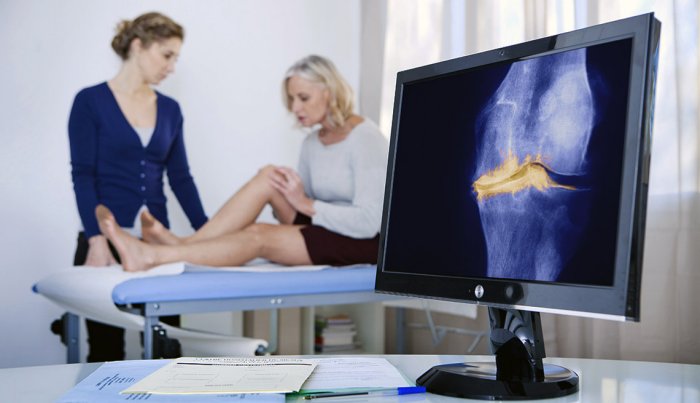Some chronic conditions tend to start cropping up in midlife. Here's what to do about them
There's a lot to celebrate when you hit the big five-oh. Discounts start to kick in, investments begin to mature and — how does the saying go? — with age comes wisdom.
But for all the money saved and knowledge earned, there's a small price to pay: It's time to really start tuning in to your health.
"What we see is that some chronic health conditions are frequently diagnosed starting at age 50,” says Renuka Tipirneni, M.D., an internist and assistant professor in the Division of General Medicine at the University of Michigan.
The good news is that many of the conditions that creep up in midlife can be managed. And if they're caught early and treated promptly, you can “prevent complications that are more serious,” Tipirneni explains.
Here's what you need to look out for after you turn 50.
1. High blood pressure
A common condition health care providers see among patients in their 50s is high blood pressure, which is a major risk factor for heart disease and stroke.
One reason high blood pressure is so prevalent in this age group is that the vascular system changes as we age. Arteries start to stiffen and become less elastic, and the pressure inside them builds. The extra weight and stress that often accompany middle age can also contribute to creeping numbers.
The good news: High blood pressure is manageable with medication and lifestyle modifications, including diet and exercise. But because the condition often lacks symptoms, it's easy to miss. In fact, nearly 1 in 3 adults with high blood pressure don't know they have it, according to the Centers for Disease Control and Prevention (CDC).
That's why Tipirneni recommends getting your blood pressure checked “more regularly” — at least every year — once you hit 50.
If you have a blood pressure cuff at home (they cost about $30), you can check it yourself. And pharmacies and health fairs often offer blood pressure checks for free, Tipirneni points out. Of course, your health care provider can also take it for you.
What you want to see is a reading at or below 120/80, which is considered normal by the American Heart Association. Anything over 130 on that top number (the systolic reading) is considered high and warrants a conversation with your doctor about possible treatments.
2. High cholesterol
Another contributor to heart disease is high cholesterol, which can build up on the inside of the blood vessels over time and form plaque that slows or blocks blood flow. This plaque can also break loose and cause a blood clot — even a heart attack or stroke.
Similar to high blood pressure, your risk for developing high cholesterol increases with age. It also comes with no symptoms or warning signs, which is why it's important to check your numbers regularly throughout midlife with a routine blood test that can be done at the doctor's office. Diet and exercise can help lower cholesterol, as can medication.
3. Diabetes
While you're getting your blood checked for cholesterol, your health care provider may also screen you for diabetes — another common condition that creeps up in your 50s and can wreak havoc on your health. More than 34 million Americans have diabetes — the vast majority have type 2 diabetes — and those in middle age are most at risk, according to the CDC.
Diabetes can often be managed with lifestyle changes, including a healthy diet and physical activity. “Sometimes we need to add some medications as well” to help control blood sugar (glucose) levels, says Kate Lorig, professor emeritus at the Stanford University School of Medicine and a partner at the Self-Management Resource Center.
As with high blood pressure and cholesterol, the warning signs of diabetes are often silent, which is why it's important to get screened. If left untreated, diabetes can lead to a whole host of health conditions, including kidney disease, vision loss and heart disease.
Warning Signs of Heart Disease
High blood pressure, high cholesterol and diabetes are three leading risk factors for heart disease, which is the number one cause of death in the U.S.
Do you know the warning signs?
"Most people worry about chest pain,” says Renuka Tipirneni, M.D., an internist and assistant professor in the Division of General Medicine at the University of Michigan. Pain in the chest is an indication that something could be wrong, but there are other symptoms, too, including:
- Unexplained back pain that happens when you exercise
- Pain in the neck, jaw or throat
- Pain in the upper abdomen
- Shortness of breath
- Nausea, vomiting, fatigue
- Dizziness
- Heart palpitations
If you experience any of these symptoms and are at risk for heart disease, it's important to get “evaluated emergently,” Tipirneni says.
Source: Renuka Tipirneni, M.D./CDC
4. Arthritis
One condition that pops up in your 50s but is regularly overlooked or dismissed is arthritis — especially osteoarthritis, which Tipirneni refers to as “the wear-and-tear-type of arthritis” that occurs when the joint cartilage between bones is damaged or breaks down.
"It can be very aggravating even younger than age 50, but especially over age 50, we see pain associated with that is coming up more and more,” she says.
If you notice joint pain or stiffness from daily activity, talk to your health care provider. You'll want to make sure it's not rheumatoid arthritis, which is an autoimmune and inflammatory disease.
Treatment for osteoarthritis runs the gamut. Increasing physical activity can help prevent further pain or disability, Tipirneni says. Your health care provider may also recommend over-the-counter or prescription pain relievers to alleviate discomfort.
5. Osteoporosis
Women in particular need to pay attention to their bone health once they hit 50 — that's when osteoporosis, or the weakening of the bones, becomes most common. In fact, almost 20 percent of women 50 and older have osteoporosis, the CDC says.
That's because one of the risk factors for osteoporosis is being postmenopausal, explains Lucy McBride, M.D., a Washington, D.C.-based internist. “When you stop making estrogen, your bone density typically goes down,” she says. The average age for menopause among women in the U.S. is 51, according to the Mayo Clinic.
Weight-bearing exercises — walking and upper-body strength training, for example — can help reduce your risk for developing osteoporosis. So can paying attention to your calcium intake and vitamin D levels, both of which are important to bone health.
6. Cancer
Because advancing age is the biggest risk factor for cancer, keeping up with routine screenings becomes important in your 50s.
Women in this age group should get a mammogram at least every two years to screen for breast cancer, and men should talk to their health care providers about prostate cancer screenings. Colon cancer screenings also become more regular — for both men and women.
7. Anxiety/depression
Whether it's teenagers, work or aging parents that keep you busy in midlife (or all of the above), chances are, you're stressed. And all that stress can take a toll on your mental health, which in turn affects your physical health.
"Because at the end of the day, your blood pressure, your weight, your cholesterol, your cancer risk — all those biometric [measurements] are rooted in your behaviors. And those behaviors are rooted in your emotional health,” McBride says.
About 20 percent of people age 55 or older experience some type of mental health concern, according to the CDC, and anxiety and depression are among the most common. The coronavirus pandemic has only amplified this crisis. During the pandemic, about 4 in 10 American adults have reported symptoms of anxiety or depressive disorder, a Kaiser Family Foundation poll found. Before the pandemic, this number was 1 in 10.
McBride's advice? “You really need to make sure you're bringing your whole self to the doctor” and talking to your health care provider about your stress levels and your relationship with food and alcohol, she says.
"Your brain is just like any other organ. We have heart health, we have breast health, we have skin health, we have kidney health. We also have mental health. It needs to be addressed,” McBride adds.
Mind your immune system
Another thing to bring up with your health care provider once you turn 50 is immunizations.
"Vaccines become much more important, because at this age group, our immune systems start to wane a little bit, and so you're more at risk for infections,” Tipirneni says.
In addition to the annual flu shot, your provider may suggest a shot that prevents pneumonia. There's also a vaccine recommended for adults 50 and older to prevent shingles and the complications from the disease.
Finally, three vaccines have been authorized under emergency use by the Food and Drug Administration to prevent COVID-19, which has been especially deadly in adults 50-plus.
Rachel Nania writes about health care and health policy for AARP. Previously she was a reporter and editor for WTOP Radio in Washington, D.C. A recipient of a Gracie Award and a regional Edward R. Murrow Award, she also participated in a dementia fellowship with the National Press Foundation.




No comments:
Post a Comment